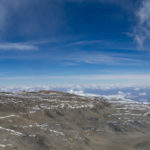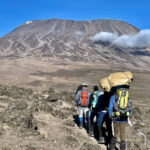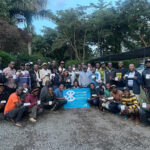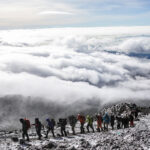Kili is sometimes thought of as the “easiest” of the seven summits because its relatively gentle slopes require no technical mountaineering expertise.
But at 19,341 feet, Kili’s summit is solidly in the “extreme altitude” range. Potential climbers may not have to rappel down sheer cliff faces, but they should definitely account for the effects of altitude on the body. Kili’s overall summit success rate hovers around 50%, likely in large part because the ease of the climbing blinds people to the importance of adjusting to altitude on the mountain (budget trekking companies who try to herd climbers to the top as quickly as possible, building in little if any acclimatization time, also contribute to lower overall summit success).
Without proper acclimatization time, very serious health issues can develop. Most Thomson trekkers choose longer routes that help minimize the chances of these issues occurring, and our certified Wilderness First Responder guides receive intensive training to spot (and stop) any serious problems before they start. They’re also equipped with the most extensive medical equipment available and perform daily health checks on all climbers; Thomson trekkers can be confident that their health and safety on the mountain is our #1 priority.
 Photo taken by Thomson Safaris guest, Meghan Carye
Photo taken by Thomson Safaris guest, Meghan Carye
–
But even with ample acclimatization time, many trekkers experience some of the more ‘normal’ effects of altitude, from headaches and mild nausea to vomiting and shortness of breath. As you climb, there are a few things to keep in mind:
1.) Your fitness level doesn’t affect acclimatization
You can, and should, train for your climb, but you can’t “train” for altitude. Incredibly fit people can experience difficulty, and people who have never hiked before might feel fine. This is because your reaction to altitude relies on two factors: your genetic makeup (studies have shown that populations living at high altitude, like the Nepalese, have different lung capacities, blood oxygenation, and red blood cell counts than lowlanders), and acclimatization time.
You can’t change your gene pool, so give yourself as much acclimatization time as possible. It’s estimated that full acclimatization requires 11.4 days for every kilometer you travel above sea level; for your body to fully adapt to oxygenation levels at Kili’s summit, you’d need over 67 days! But with 9-10 days on Kilimanjaro we’ve found that people do exceptionally well, resulting in Thomson’s 98% summit success rate.
2.) Your reaction to altitude can change from climb to climb
General altitude tolerance isn’t something you “build up” (unless you never return to lower altitudes); you may experience little to no effects of altitude on one climb and be hard-hit on the next (or vice versa!). It’s important to give yourself ample acclimatization time on every climb, even if you don’t think you’ll need it.
3.) A bad day doesn’t mean you won’t summit
A bad day on the mountain doesn’t mean you’re doomed; it absolutely can (and usually does) get better after it gets worse! If you do experience altitude symptoms, your guide can probably help; he might tell you to take it easy, or even just to drink more water. He wants you to reach the summit, so he’s going to make sure you feel as healthy as possible during your trek.
You can also consult with your doctor before you leave; acetazolamide, commonly sold under the name “Diamox,” can be taken leading up to and during your trek as a sort of “preventative medicine” for altitude issues.
Even if you have a rough day, don’t give up; every single Thomson staff member had at least one day on Kilimanjaro when they wondered if they could really do it…and every single one of them summited.
We know you can do it too!






